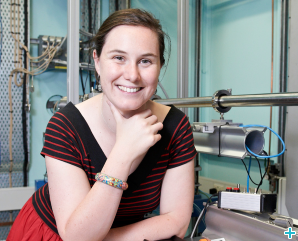Helen Maynard-Casely
Instrument Scientist at the Australian Centre for Neutron Scattering in ANSTO
Can you tell us about your studies and your scientific field?
I’m interested in the small molecules that make up much of the mass of our solar system, such as water, methane and ammonia. From methane in the interiors of Neptune and Uranus, to hydrates on the surface of Europa, I study the crystal structures and physical properties these materials take up. The main tool I use for these studies is diffraction, and neutron diffraction has always been an essential technique for me. Analysis of neutron diffraction allows me to place hydrogen atoms in the structures and explain their roles in the overall material properties.
What´s your Neutron-scattering background?
I first worked with neutron scattering during my PhD, where I learn the ropes of high-pressure neutron diffraction. During this time I collected data at ISIS and ILL, and complemented my work with data collections from a number of synchrotron sources.
Can you describe step by step how you got to your position?
My undergraduate studies were in Planetary Science at University College London, and I moved from there to undertake my PhD in high-pressure physics at University of Edinburgh. I held a short post-doc in Edinburgh before having a break from traditional research to work on the Royal Institution of Great Britain’s Christmas lectures in 2010. After this I moved to Australia, to a post-doctoral fellowship at the Australian Synchrotron where I stayed until July 2013 before moving to be an Instrument Scientist at ANSTO.
Quite a journey so far! I’m not sure that I would say obtaining any position (especially in scientific professions) is a step-by-step process. I’ve very much enjoyed the variety and range of opportunities that have been available to me, and hope have taken good advantage of each of them.
Have you got any publications?
Yes, I’m an author on 26 peer-reviewed scientific papers (as of November 2016) and have given a number of conference presentations. I’m also the author of the ‘Shores of Titan’ blog on The Conversation my writing was featured in the Best Australian Science Writing 2012 and I am a contributor to Cosmos magazine.
Who or what is your mentor or greatest inspiration?
I’m very fortunate to have found in Australia a number of fantastic mentors who have encouraged and challenged me to my current successes. I draw a lot of inspiration from one of the founders of crystallography, Lawrence Bragg. Not only for the inspired and broad directions that he took the technique, but also for the pioneering communication of his work to a very wide audience.
What is the most challenging thing you have faced in your career?
Probably moving to Australia, where I knew little about the scientific community. I was also returning to research after a break working in a very different position. However, being based at a large facility was ideal, as I got to meet on a weekly basis new scientists from all across the scientific community. Also the community here are very collaborative, and I have found my research skills valued enabling me to make contributions to a range of very interesting projects.
Contact details
Helen Maynard-Casely
Instrument Scientist
Australian Centre for Neutron Scattering, Australian Nuclear Science and Technology Organisation (ANSTO)
Locked Bag 2001, Kirrawee DC, NSW, 2232, Australia
helen.maynard-casely@ansto.gov.au
Helen is also the instigator of Crystal365.

